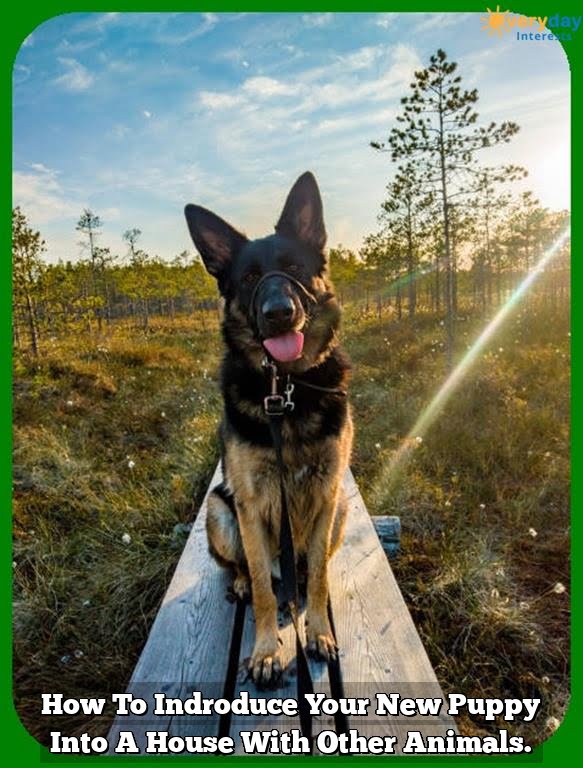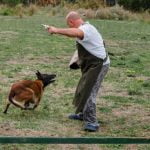Are you interested in learning how to train a puppy into a guard dog? The process may seem daunting, but with the right guidance and techniques, it is possible to nurture your puppy’s natural protective instincts.
In this article, we will explore the important steps and considerations for training a puppy into a reliable guard dog. From understanding the role of a guard dog to advanced protection training, we’ll cover everything you need to know to set your pup up for success.
Before diving into the training process, it’s crucial to understand the role of a guard dog. These loyal and protective canines are trained to ensure the safety and security of their owners and property. A well-trained guard dog serves as an effective deterrent against intruders and can provide peace of mind for homeowners. By following the proper training techniques, you can help your puppy develop the skills needed to become a dependable guardian.
When embarking on the journey of training a puppy into a guard dog, it’s essential to start with foundational obedience and socialization training. This lays the groundwork for more advanced protection training down the line. Building trust and creating a secure environment are also key components in developing a strong bond between you and your pup.
Additionally, understanding the legalities and responsibilities of owning a guard dog is crucial in ensuring that both you and your canine companion adhere to regulations. By addressing these fundamental aspects, you can pave the way for successful guard dog training.
Choosing the Right Puppy for Guard Dog Training
When selecting a puppy for guard dog training, it’s important to choose a breed that is known for its protective instincts, intelligence, and loyalty. Breeds such as German Shepherds, Rottweilers, Doberman Pinschers, and Belgian Malinois are commonly chosen for guard dog training due to these qualities. It’s crucial to research and understand the specific characteristics of each breed before making a decision.
Once you have chosen a suitable breed, it’s essential to select a puppy with the right temperament and personality for guard dog training. Look for puppies that exhibit confidence, curiosity, and attentiveness. Avoid puppies that show signs of fearfulness or aggression as they may not be suitable for training as a guard dog.
Proper socialization from a young age is also crucial when choosing a puppy for guard dog training. Exposing the puppy to various environments, people, and animals will help them develop into well-rounded guard dogs that can confidently navigate different situations. It’s important to start this process as early as possible to ensure that the puppy grows up with good social skills.
| Aspect | Details |
|---|---|
| Breed Selection | German Shepherds, Rottweilers, Doberman Pinschers, Belgian Malinois |
| Temperament | Confidence, curiosity, attentiveness |
| Socialization | Vital for developing good social skills |
Basic Training
Start With a Solid Foundation
Before diving into the advanced training techniques for turning your puppy into a guard dog, it is essential to lay a solid foundation of basic obedience and socialization. This includes teaching your puppy fundamental commands such as sit, stay, come, and heel. These basic obedience commands are crucial for ensuring that your puppy can follow directions and behave appropriately in various situations.
Socialization Is Key
Socialization is another essential aspect of training a puppy to become a well-rounded guard dog. Exposing your puppy to different people, animals, and environments from a young age will help them feel at ease in various situations and reduce the likelihood of aggression towards strangers or other dogs. It is crucial to introduce positive experiences with new sights, sounds, and experiences during this critical developmental period.
Consistency Is Crucial
Consistency is key when it comes to basic obedience training. It’s important to set clear expectations for your puppy’s behavior and consistently reinforce these expectations through positive reinforcement techniques such as treats, praise, and rewards. Additionally, using the same commands and hand signals consistently will help your puppy understand what is expected of them. Remember that patience and persistence are essential when teaching obedience and socialization skills to your puppy.
By laying a strong foundation of basic obedience and socialization, you are setting the stage for successful advanced training in protection and alertness. These fundamental skills will also help create a well-behaved and confident guard dog that can effectively fulfill their role while still behaving appropriately in various situations.
Overall, basic training lays the groundwork for developing a well-rounded guard dog who can effectively carry out their protective duties while also being well-behaved in everyday life.
Advanced Training
Teaching Protective Behaviors
Once your puppy has mastered basic obedience and socialization, it’s time to start teaching them the specific behaviors associated with being a guard dog. This includes training them to perceive potential threats and respond accordingly.
One effective way to do this is through controlled scenarios where you act as the “intruder” and teach your puppy to bark or growl on command. It’s important to remember that while a guard dog needs to be protective, they also need to be under control at all times.
Alertness Training
In addition to protection, a good guard dog needs to have heightened alertness and awareness of their surroundings. You can start by exposing your puppy to different sounds, sights, and smells in their environment. Training them to pay attention to unusual activity or noises will help them develop the instinctive alertness needed for their role.
Maintaining Proper Control
While training your puppy for protection and alertness, it’s crucial to maintain proper control over their behavior. This means reinforcing obedience commands even in high-stress situations and ensuring that they only respond when given a specific command from their owner or handler. In this way, you can ensure that your guard dog is both attentive and obedient.
Remember that advanced training for a guard dog takes time, patience, and consistency. It’s important not to rush the process and ensure that your puppy is properly prepared for their future role as a protector.
Building Trust and Bonding With Your Puppy
When training a puppy to become a guard dog, it is essential to focus on building a strong bond and trust with your furry companion. Guard dogs need to have a deep sense of loyalty and attachment to their owners in order to effectively fulfill their role. One way to build trust with your puppy is through positive reinforcement training. This means using rewards such as treats, praise, and playtime to encourage good behavior.
Another important aspect of building trust with your puppy is spending quality time together. Regular walks, training sessions, and playtime can help strengthen the bond between you and your puppy. It is also crucial to provide a safe and nurturing environment for your puppy, as this will help them feel secure and develop a strong attachment to you.
Additionally, socialization plays a significant role in building trust and bonding with your puppy. Exposing them to different environments, people, and animals from an early age can help them develop confidence and adaptability. This will ultimately contribute to the overall success of their guard dog training.
It is important to keep in mind that building trust and bonding with your puppy takes time and patience. Every interaction with your puppy should be based on mutual respect and understanding. By investing in this relationship early on, you will set the foundation for successful guard dog training in the future.
| Aspect | Importance |
|---|---|
| Positive reinforcement training | Encourages good behavior |
| Quality time together | Strengthens the bond |
| Socialization | Develops confidence |
Creating a Safe and Secure Environment for Training
When training a puppy to become a guard dog, creating a safe and secure environment for their development and training is crucial. Here are some key steps to consider when creating an optimal environment for your puppy’s training:
- Secure Enclosure: Ensure that the training area or enclosure is secure and free from potential hazards. This could include fencing off the area, removing any toxic plants or substances, and providing a comfortable shelter for your puppy.
- Training Equipment: Invest in quality training equipment such as a sturdy leash, a well-fitted collar, and appropriate protective gear if you’re engaging in advanced protection training. It’s important to prioritize safety for both you and your puppy during the training process.
- Positive Reinforcement: Create a positive and encouraging atmosphere during training sessions. Use rewards like treats and verbal praise to reinforce desired behaviors. This will help your puppy feel safe, secure, and motivated during their training.
Additionally, it’s essential to establish clear boundaries within the training environment to help your puppy understand their role as a guard dog. Having designated areas for rest, play, and training can aid in their overall understanding of their duties.
Ultimately, creating a safe and secure environment for your puppy’s guard dog training will not only help them develop essential skills but also foster trust between you and your canine companion. Remember that patience, consistency, and positive reinforcement are key components of successful guard dog training.
Understanding the Legalities and Responsibilities of Owning a Guard Dog
Owning a guard dog comes with certain legalities and responsibilities that every owner must be aware of. It is important to understand the laws and regulations in your area regarding owning a guard dog, as they can vary from one location to another. Some areas may have specific requirements for owning a guard dog, such as registering the dog as a guard dog, obtaining liability insurance, or posting warning signs on your property.
In addition to legal requirements, it is important to understand the responsibilities that come with owning a guard dog. This includes properly training and socializing the dog to ensure it does not pose a danger to others.
Owners must also take steps to prevent their guard dog from being a nuisance or threat to neighbors or visitors. It is crucial for owners to be mindful of their guard dog’s behavior at all times and take proactive steps to address any potential issues that may arise.
Furthermore, it is essential for owners of guard dogs to be aware of their liability in the event that their dog causes harm to others. Owners may be held accountable for any damages or injuries caused by their guard dog, so it is important to take every precaution necessary to prevent such incidents from occurring.
This includes properly securing the property, providing adequate supervision and training for the guard dog, and seeking professional help if there are any behavioral concerns. Understanding these legalities and responsibilities is vital for anyone considering training a puppy into a guard dog.
Overall, being knowledgeable about the legalities and responsibilities of owning a guard dog is crucial for ensuring the safety of both the owner and the public. By understanding and adhering to local laws and regulations, taking proactive measures to prevent potential issues, and seeking professional help when needed, owners can enjoy the benefits of having a well-trained guard dog while minimizing any potential risks or liabilities.
Maintenance and Continued Training for a Well-Trained Guard Dog
Maintaining a well-trained guard dog requires consistent effort and ongoing training. Once your puppy has completed basic and advanced training, it is essential to continue reinforcing their skills and instilling good behavior. Here are some tips for maintaining and continuing the training of your guard dog:
- Regular Exercise: Just like any other dog, a guard dog needs regular exercise to stay healthy and release pent-up energy. This can include daily walks, playtime, or even agility training to keep them physically fit and mentally stimulated.
- Continued Obedience Training: Consistency is key when it comes to obedience training for guard dogs. Regular practice of commands such as “sit,” “stay,” “heel,” and “come” will help reinforce good behavior and maintain their responsiveness to your instructions.
- Socialization: It’s important to continue exposing your guard dog to different people, animals, and environments to ensure they remain well-socialized. This can help prevent them from becoming overly protective or aggressive in unfamiliar situations.
- Scent Work: Incorporating scent work into your guard dog’s training can help keep their senses sharp and provide mental stimulation. This could involve hiding treats or toys for them to find or introducing them to tasks such as tracking.
By consistently providing mental stimulation, physical exercise, ongoing obedience training, socialization opportunities, and scent work, you can ensure that your guard dog remains well-trained and well-adjusted throughout their life.
Conclusion
In conclusion, training a puppy to become a guard dog is a serious commitment that requires dedication, patience, and the right resources. While it is possible to train a puppy into a guard dog through various methods and techniques, it is important to recognize the value of professional help and resources in this process.
Professional guidance from experienced trainers can provide valuable insights and expertise in shaping your puppy into a well-trained guard dog. They can offer personalized training programs tailored to your puppy’s specific needs, as well as address any behavioral issues or challenges that may arise during the training process.
Furthermore, utilizing resources such as books, online courses, and community support can also be beneficial in gaining knowledge and understanding of effective training methods for guard dogs. These resources can provide supplemental information and guidance that can enhance your ability to train your puppy effectively.
Ultimately, while it is possible for dedicated owners to train their puppies into guard dogs on their own, seeking professional help and utilizing available resources will greatly increase the likelihood of success in this endeavor. By investing in the proper guidance and education, you can ensure that your puppy receives the best possible training to become a reliable and well-trained guard dog.
Frequently Asked Questions
Can You Train Your Puppy to Be a Guard Dog?
Yes, you can train your puppy to be a guard dog with the right techniques and methods. It’s important to start training early and to use positive reinforcement to teach them the appropriate behaviors.
How Do I Train My Puppy to Be a Protector?
To train your puppy to be a protector, you should focus on socialization, obedience training, and desensitization to various stimuli. Teaching them basic commands and building their confidence are also crucial for this type of training.
How Long Does It Take to Train a Dog to Be a Guard Dog?
The time it takes to train a dog to be a guard dog can vary depending on the breed, age, and individual personality of the dog. Generally, it can take several months to a year of consistent training to fully develop the guard dog skills in your pet.

Welcome to the blog! I am a professional dog trainer and have been working with dogs for many years. In this blog, I will be discussing various topics related to dog training, including tips, tricks, and advice. I hope you find this information helpful and informative. Thanks for reading!





